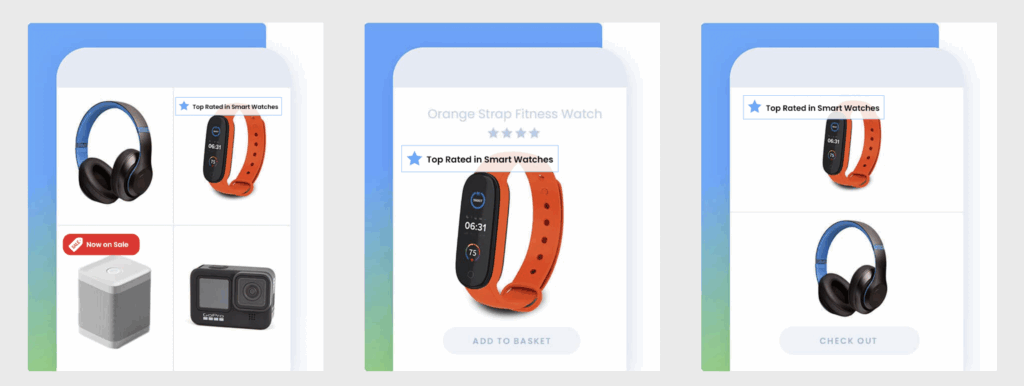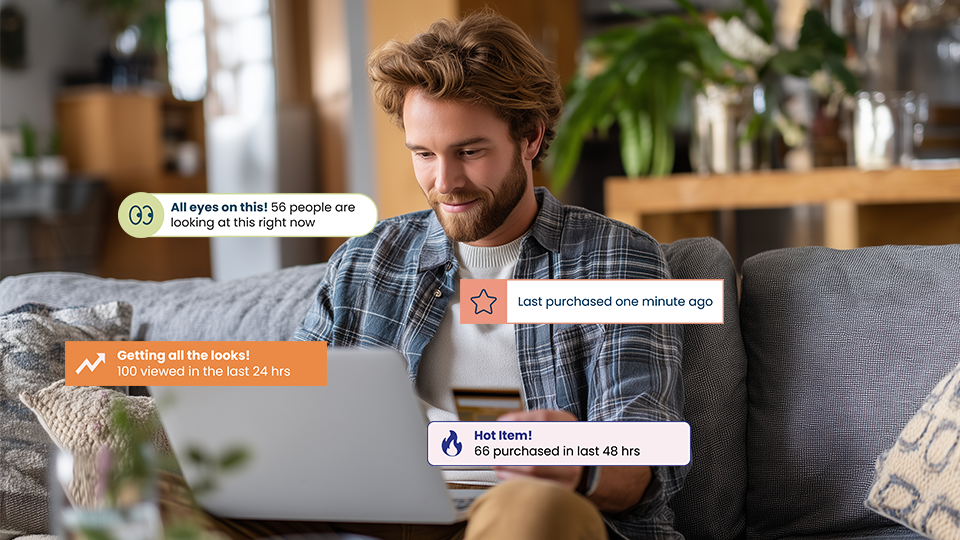Ecommerce product badges are widely used in eCommerce to highlight specific products with messages such as “New”, “On Sale”, or other promotional messages. These types of badges are so common that a benchmark of leading retailers in the US found that nearly 90% use some sort of badging on their sites.
There’s a reason why product badges are so popular. Product badges allow merchandisers to fairly easily highlight products and specific messages to shoppers, encouraging them to make faster and more confident purchase decisions.
While traditional static badges offer clear benefits, some retailers are moving beyond the basics to improve performance and automate otherwise manual processes with Dynamic Badging. Dynamic product badging uses defined merchandising filters to create rules to automatically display badges. This helps reduce manual processes and increasing efficiency.
In this post, we’ll explore the fundamentals of product badging, how they shape buyer behaviour, and why you should invest in dynamic badging.
What are eCommerce Product Badges?
Ecommerce product badges are visual labels – typically displayed on, or near, product images on product list pages and product detail pages – used to highlight key information and draw shopper attention. Many different types of product badges can be used in various ways along the customer journey, including:
- New Arrival / Just In
Retailers use New Arrival or Just In badges to highlight newly launched product or stock replenishments. These badges typically appeal to curious shoppers and tap into early adopter behaviour. - Limited Stock / Low Inventory
Badges to indicate when inventory drops below a certain threshold can help create urgency and FOMO (fear of missing out), driving shoppers to make a purchase decision. - Price Drop / On Sale
To capture the attention of value-driven shoppers and drive higher conversions, retailers can use Price Drop and On Sale badges, highlighting discounts and promotions. - Exclusive / Online Only
Exclusives and Online Only badges are used when products are not available in-store or are unique to the eCommerce site. These types of badges are used to promote rarity and signal perceived value. - Bestseller
Bestseller badges are social proof messages that are used to indicate when a product is consistently outperforming other products in sales either overall, within a specific product category or collection of products. Retailers typically use bestseller badges to tap into the power of social proof where shoppers buy because they trust the behaviours and choices of other customers.
Psychologically, product badges tap into triggers that can significantly influence buying behaviour. For example, Limited Stock may prompt a shopper to quickly add to cart to avoid missing out on a product while Top Rated taps into the power of reviews and social proof.
In a crowded digital marketplace, product badging is an impactful merchandising tool that simplifies decision-making and nudges customers toward conversion; however, traditional badge management can be cumbersome and time-consuming for merchandising teams. Dynamic Badging offers more efficient badge management by automating the process, freeing up resources for merchandising and IT teams to focus on other strategic activities that drive business growth.
Why Product Badging Matters in Ecommerce
Product badging plays a critical role in shaping shopper behaviour and enhancing the online user experience. On a crowded eCommerce site with a wide product selection, badges help products stand out by visually calling out relevant information. Badges can also create urgency with labels such as Low in Stock, nudging shoppers to make a purchase decision before it is too late.
Product badging is a merchandising tool that eCommerce retailers use to boost visibility, improve product discovery and increase conversion rates. However, if overused, badges can have a negative impact on the user experience. As a shopper, if you see multiple products all labelled as “New” or “Top Rated”, the information that conveys is less powerful each time and creates “message blindness” or “message fatigue”.
Traditional Product Badging Challenges
Implementing product badging in eCommerce is often a manual and resource-intensive process. Merchandising teams are typically responsible for creating badge rules, identifying qualifying products, and updating badges across the site, sometimes even relying on IT resources to implement changes.
This workflow can be time-consuming and prone to human error, particularly for retailers managing large or frequently changing product catalogues. The manual process also limits scalability and responsiveness, making it challenging to maintain accurate and timely badge updates in fast-paced retail environments. Outdated or inconsistent badges can undermine customer trust and reduce the impact of key promotional or behavioural signals.
To overcome these challenges, forward-thinking retailers are adopting automated product badging solutions. These tools eliminate the need for constant manual oversight or IT intervention, enabling real-time updates based on live data, shopper behavior, or inventory levels. By automating product badging, retailers can ensure greater accuracy, enhance the customer experience, and increase conversion rates without overburdening internal teams.
Introducing Dynamic Badging – automating eCommerce product badging
Taggstar’s Dynamic Badging automates the process of creating and updating badges by using various merchandising rules to highlight on sale, low stock, new items, and more.
With dynamic badging, badges are automatically displayed on qualifying products, significantly reducing manual effort. Badges can be defined using filters like price, sale price, percent discount, stock, brand, category and more. Filters can also be used in combinations to create more complex scenarios.
Dynamic badges can be used across the eCommerce site to create more engaging shopping experiences while helping shoppers more easily spot products to buy. On busy product list and category pages, product badges help improve product discovery and reduce time to check-out. On the product page, badges help reduce bounce rates by highlighting relevant information that nudges shoppers to add to cart. Finally, in the cart, dynamic badges help reduce cart abandonment and increase conversion rates by reinforcing key information that makes shoppers feel more confident about their purchase decisions.

Unlock Higher Ecommerce Conversions with Dynamic Badging
Product badging is a proven eCommerce tactic used to highlight specific products, drive engagement and increase conversions. However, many retailers still rely on manual processes to manage their badging strategy, inherently resulting in lags and human errors.
Dynamic Badging enhances traditional product badging by allowing retailers to create rules that automate the process of creating product badges. By automating the badging process, retailers are able to reduce the manual effort required to update product labels, thereby allowing merchandising teams to focus on other strategic growth initiatives.
Dynamic Badging works seamlessly with Taggstar’s social proof and attribute messaging tools, ensuring cohesive, persuasive messaging strategies across the entire digital shopping journey.
Discover how Taggstar’s Dynamic Badging solution can automate and elevate your eCommerce merchandising strategy. Contact us to schedule a demo.



